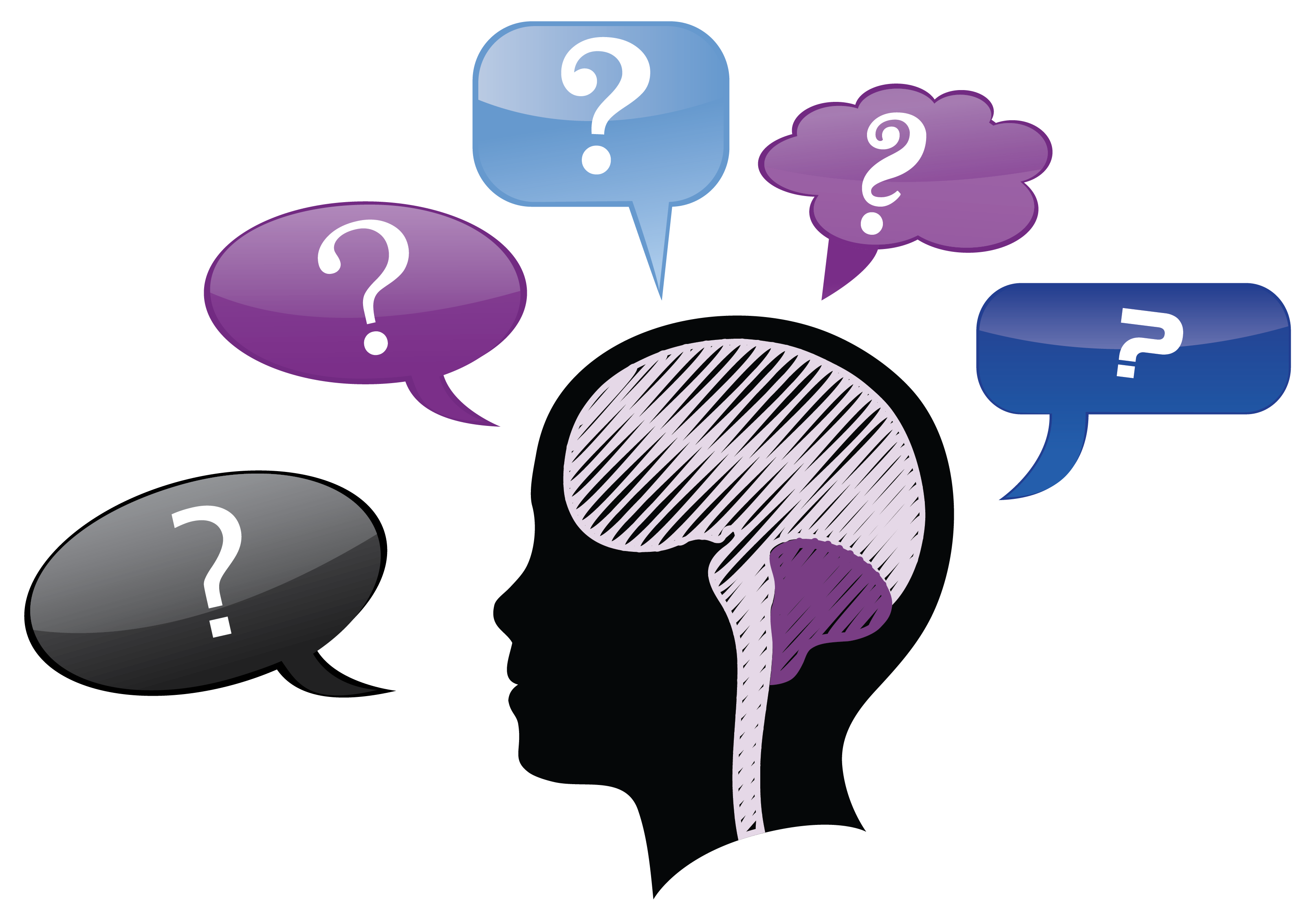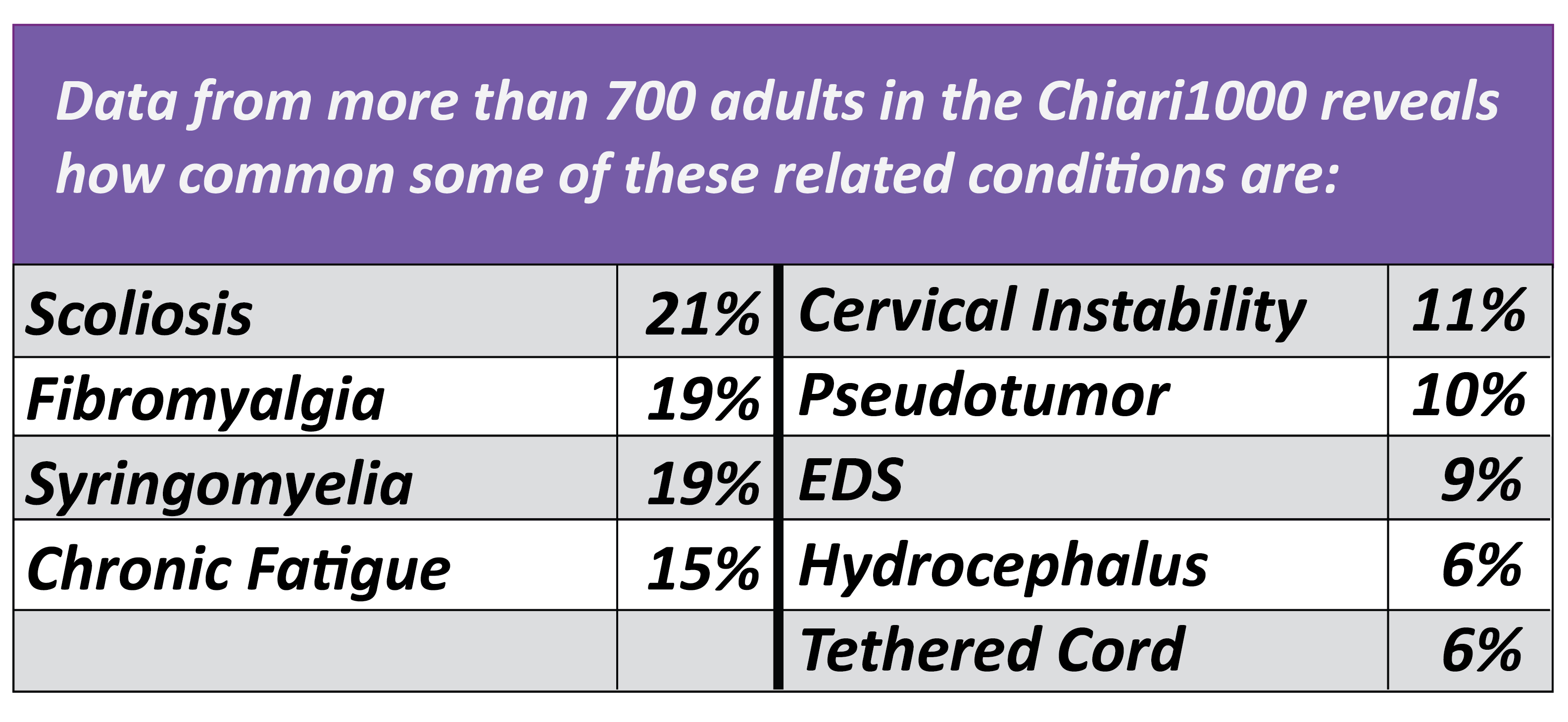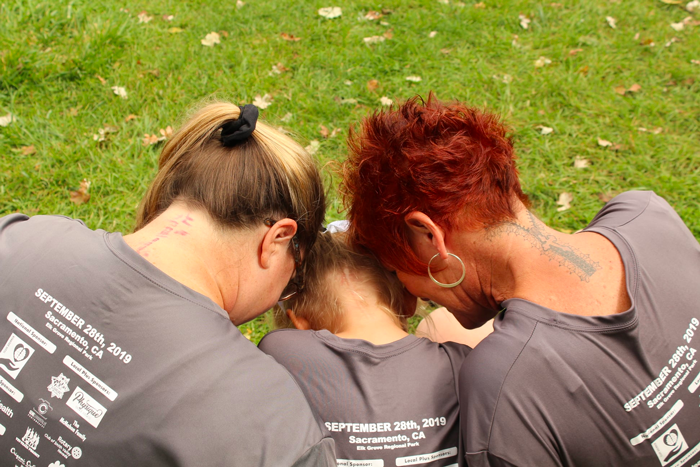Chiari affects everyone differently, but common symptoms include…

MRI
An MRI is a complex machine that uses magnetic fields to manipulate and measure water content (hydrogen) in order to create a representation of what is inside the body. It builds the image set through a series of slices in different directions.

During the first year a patient can expect to undergo several MRI scans with repeated follow-ups in the years to come

What to Expect
After the initial waiting time in the reception area a technician will explain the process, ask a series of questions, and lead you into the MRI room
Once inside the generally cold MRI room, you will lie down on a flat bed
Because the machine is loud, you will be given ear plugs to protect your ears or headphones to listen to music and communicate with the technician
Depending on the equipment, a coil may be placed over your face like a mask
The bed will then slide into the machine, you will have a panic button to push in an emergency
For the next 20 minutes to 1 hour, the machine will make a series of loud noises, occasionally changing positions
Phase-contrast MRI (cine-MRI)
Phase-contrast is taken the same way as a traditional MRI, with the addition of either a wristband or EKG leads on the patient’s chest to measure the heart rate
The MRI machine is used in the same way as a traditional MRI, however, the operator will program the MRI a little differently and the computer that generates the image(s) will interpret the data it receives differently in order to show movement
Phase-contrast allows for the visualization of cerebrospinal fluid (CSF) flow and can be used to determine if a Chiari malformation is blocking the natural back and forth flow of CSF between the brain and spine and how large the blockage is
Limitations of MRI
The strength of the magnet
The MRI manufacturer
The patient’s head position
The patient’s movement in the machine
The settings on the machine
The end result is that the same person having an MRI twice, even in the same machine, will result in different pictures

Missed Diagnoses - Misdiagnoses
Missed Diagnoses occur when physicians ascribe initial symptoms to stress or other factors. Unfortunately, some patients are told their symptoms are psychological in nature. In other cases, patients are told that Chiari is not the cause of their symptoms or that Chiari is nothing to worry about and they were just born that way. Misdiagnoses occur when the many possible symptoms of Chiari are associated to other conditions, such as: MS, Fibromyalgia, Chronic Fatigue, Lupus, Migraines, Carpal Tunnel Syndrome and ALS (Lou Gehrig’s). These associations cause confusion to the medical situation and can result in critical delays in getting proper treatment
Diagnostic Tests
The paths people take to a Chiari diagnosis are as numerous and varied as its many symptoms. There is no single objective test to diagnose symptomatic Chiari
The average adult waits 30 months for a Chiari diagnosis.
Most common tests:
Neurological Exam- a way to explore what is happening to the nervous system by examining how different parts of the body respond to different forms of stimulus and functional tasks
MRI- Magnetic Resonance Imaging, creates an image of the brain and spine
Cine-MRI- also known as phase-contrast MRI, creates an image of the flow of spinal fluid
Other tests:
X-Rays
CT Scans
Hearing Vision
Upright MRI
Vestibular
Urodynamic
Neuropsychological
Experts recommend that anyone diagnosed with Chiari should have an MRI of their entire spine.
Pediatric Diagnosis
Children cannot always verbalize what they are feeling, sometimes the first clue is lack of proper development, either physically or cognitively. Some children will bang their heads when they can’t verbalize that their head hurts. Symptoms may result in changes in behavior and attitude. MRIs require the patient to remain still for an extended period of time which is not easy for a young child. Young children may need to be anesthetized. In older children, unusual presentations of scoliosis are a strong indication that an MRI should be performed.

The first step in getting proper treatment for Chiari is to find the right doctor. While many patients are referred first to a neurologist, given that the only real treatment for Chiari is surgical, Conquer Chiari recommends that patients see a neurosurgeon for evaluation.
As a policy, Conquer Chiari does not refer people to specific neurosurgeons
1. There is no professional certification or sub-specialty for Chiari
2. There are no objective data available on the success of individual surgeons
3. Each patient is unique and is likely to prefer different things in a neurosurgeon
How do you find a good neurosurgeon?
As such, we recommend that each patient (or parent) do the work necessary to find the neurosurgeon that is right for them. Thus, the question becomes how do you find a good neurosurgeon? There are many ways to go about it, and below are some suggestions. Keep in mind these are just suggestions, you may decide to use all of them, use some of them, or not to use any of them at all. There is no right answer, but like anything else, the more work you put into it, the better the result is likely to be.
- Set emotion aside. This can be extremely difficult to do, especially if the diagnosis has come as surprise, or if you have been told for years there is nothing wrong. However, this is an important decision, and a methodical approach to the matter can help. If necessary, recruit a family member to help you through the process.
- Establish your criteria. Everyone is looking for something different. What is right for one person may not be right for someone else. Think through what YOU, as a patient, feel is important in a doctor. Some items to consider: a. Location
- Create a list of candidates. This is the step where you create a pool of potential doctors to match against your list of criteria. You can build the list from a number of sources, including: a. The professional societies' websites
- Create a short list based on your criteria. Do what research you have to do to create a short-list of candidates. You can use the internet and phone to learn more and eliminate people from your list based on what is important to you. Or create multiple lists, for example doctors near by, or doctors you would see if you decide to travel.
- Do more thorough research on the doctors that made the short list. Ask everyone again about these specific doctors. Have they published any research? Have they won any awards? Are they listed in America's Top Doctors?
- Compare your list (plus research) to your criteria list and make a prioritized list. From this, you can set up appointments and see who you like.
- Trust Yourself. When you meet with the doctor do you get a good feeling? Can you communicate with him/her easily? In the end you may have to trust yourself to this person. Can you see yourself doing that? If so, you probably have found a good doctor for you. If not, consider seeing someone else. Don’t let other people tell you who you should see. Do the work yourself; be smart and do your homework, only you can decide who's right for you.
b. University Based or Private Practice
c. Someone who does a lot of Chiari surgeries or a general surgeon?
e. With what you know about yourself, do you have a straightforward case, or a complicated one with multiple problems?
f. Insurance and cost
b. If you live near one or more Universities with medical schools
c. Ask everyone you know
d. Use the internet
e. A lot of people use social media to find doctors.
Surgery is the primary treatment for Chiari and the decision whether to have surgery is made between the patient (or parent) and their surgeon.
Should I Have Surgery?
Doctor
Surveys have shown a range of opinions among surgeons about when they recommend surgery.
Some factors for surgery: severe symptoms, symptom progression, signs of the nervous system being affected, MRI indicates crowding around cerebellar tonsils, large and/or active syrinx
Some factors against surgery: no/mild symptoms, symptoms not necessarily due to Chiari and unlikely to respond to surgery, MRI shows no/minimal crowding
Some doctors are more aggressive than others in recommending surgery, but many report recommending surgery for 30-50% of the patients they see
Patient
Can you tolerate symptoms?
How much does it impact work, family life, etc?
Some people have a phobia associated with any type of surgery

No Surgery
If necessary treat symptoms individually
Lifestyle modifications
Monitor with regular MRIs and doctor visits (if necessary)


Surgery
Surgical Steps
Craniectomy - A piece of the skull is removed
Laminectomy - Part of one or more vertebrae are removed
Duraplasty - The covering of the brain is opened and a patch is sewn in to make it bigger
Tissue removal - Cerebellar tonsils are sometimes cauterized (controversial)
Plate insertion - Mesh is inserted where skull was removed

Images courtesy of Dr. Ghassen Bejjani
Surgical Variations/Controversies
How much bone is removed
Whether the dura is opened at all
What type of material is used for a dural graft (patch)
Whether any brain tissue is removed
Whether a mesh is put in to take the place of the removed piece of skull
Did You Know?
The AANS estimates that more than 10,000 Chiari surgeries are performed annually in the US and Canada
Chiari patients often suffer from related conditions


Ehlers-Danlos Syndrome
The Ehlers-Danlos syndromes are a group of connective tissue disorders that can be inherited and are varied both in how they affect the body and in their genetic causes. They are generally characterized by joint hypermobility (joints that stretch further than normal), skin hyperextensibility (skin that can be stretched further than normal), and tissue fragility.
Syringomyelia
A serious neurological disorder where a fluid-filled cyst, known as a syrinx, develops inside the spinal cord, stretching the cord and damaging nerve tissue
Symptoms
Pain in the neck, shoulders, and upper back
Numbness/weakness in arms/legs
Inability to feel hot and cold
Pain/stiffness in arms/legs
Abnormal sweating
Loss of bladder/bowel control
If left untreated Syringomyelia can lead to permanent nerve damage and paralysis
Pseudotumor (Intracranial Hypertension)
According to the Mayo Clinic, Pseudotumor cerebri (SOO-doe-too-mur SER-uh-bry) occurs when the pressure inside your skull (intracranial pressure) increases for no obvious reason
Symptoms
Moderate to severe headaches that start behind your eyes
Nausea or vomiting
Dizziness
Blurred Vision
Brief blindness affecting one or both eyes
Difficulty with side vision
Neck, shoulder or back pain
